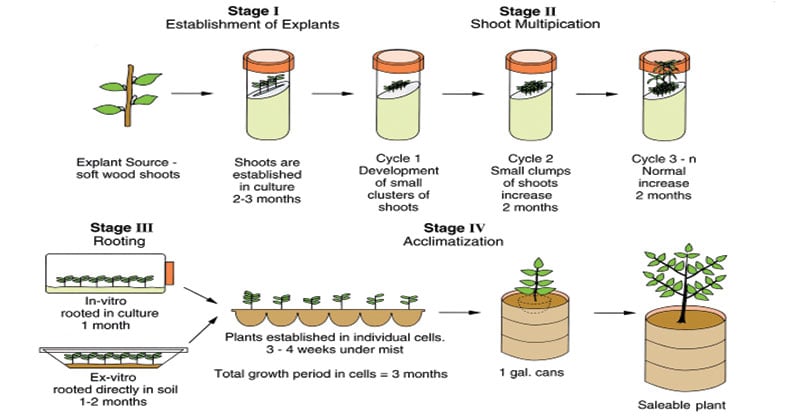Micropropagation is the rapid vegetative propagation of plants under in vitro conditions of high light intensity, controlled temperature, and a defined nutrient medium.
- The technique has been applied to a substantial number of commercial vegetatively propagated plant species.
- Plants can be propagated by sexual (through the generation of seeds) or asexual (through multiplication of vegetative parts) means.
- Asexual reproduction through multiplication of vegetative parts is the only method for the in vivo propagation of certain plants, as they do not produce viable seeds e.g. banana, grape, fig, and chrysanthemum.
Interesting Science Videos
Stages of Micropropagation

Micropropagation is a complicated process and mainly involves 3 stages (I, II, and III). Some authors add two more stages (stage 0 and IV) for a more comprehensive representation of micropropagation.
Stage 0:
This is the initial step in micropropagation and involves the selection and growth of stock plants for about 3 months under controlled conditions.
Stage I:
In this stage, the initiation and establishment of a culture in a suitable medium are achieved. The selection of appropriate explants is important. The most commonly used explants are organs, shoot tips and axillary buds. The chosen explant is surface sterilized and washed before use.
Stage II:
It is in this stage, the major activity of micropropagation occurs in a defined culture medium. Stage II mainly involves the multiplication of shoots or rapid embryo formation from the explant. A growth chamber set at 20–24 °C is used, with a 2000- to 4000-lux light intensity, and a lighting period of 16 hours or so.
Stage III:
This stage involves the transfer of shoots to a medium for rapid development into roots. Sometimes, the shoots are directly planted in soil to develop roots. In vitro rooting of shoots is preferred while simultaneously handling a large number of species.
Stage IV:
This stage involves the establishment of plantlets in soil. This is done by transferring the plantlets of stage III from the laboratory to the environment of the greenhouse. For some plant species, stage III is skipped, and un-rooted stage II shoots are planted in pots or in the suitable compost mix
Types of Micropropagation Techniques
- Micropropagation techniques are of three types based on the way of propagation: first, the propagation from shoots with cytokinin like benzyladenine or kinetin; second, multiple shoot differentiation from dedifferentiating tissue, callus, with an auxin-like indole acetic acid; and finally, the embryo differentiation from callus.
- The former two methods need the rooting process with an auxin-like indole acetic acid and with naphthaleneacetic acid thereafter.
- Nowadays, the method of propagation from shoots is the most preferred one, because the latter two methods present the possibility of genetic variation owing to the dedifferentiated phase, callus.
Applications and Advantages of Micropropagation
- Plant tissue in small amounts is sufficient for the production of millions of clones in a year using micropropagation. It would take a great deal of time to produce an equal number of plants using conventional methods.
- The technique of micropropagation provides a good alternative for those plant species that show resistance to practices of conventional bulk propagation.
- An alternative method of vegetative propagation for mass propagation is offered through micropropagation. Plants in large numbers can be produced in a short period. Any particular variety may be produced in large quantities and the time to develop new varieties is reduced by 50%.
- Large amounts of plants can be maintained in small spaces. This helps to save endangered species and the storage of germplasm.
- The micropropagation method produces plants free of diseases. Hence, disease-free varieties are obtained through this technique by using meristem tip culture.
- The proliferation of in vitro stocks can be done at any time of the year. Also, a nursery can produce fruit, ornamental, and tree species throughout the year.
- Increased yield of plants and increased vigor in floriculture species are achieved.
- Fast international exchange of plant material without the risk of disease introduction is provided. The time required for quarantine is lessened by this method.
- The micropropagation technique is also useful for seed production in certain crops as the requirement of genetic conservation to a high degree is important for seed production.
- With micropropagation having various advantages over conventional methods of propagation, this method holds better scope and future for the production of important plant-based phytopharmaceuticals.
- Independent of availability of plants, micropropagation offers a lucrative alternative approach to conventional methods in producing controlled amounts of biochemicals. Therefore, intense and continuous efforts in this field will direct controlled and successful production of valuable, specific, and yet undiscovered plant chemicals.
Limitation of Micropropagation
- Micropropagation techniques require intensive labor and this often limits their commercial application. Automation can reduce the labor required.
References
- https://www.sciencedirect.com/topics/agricultural-and-biological-sciences/micropropagation
- http://www.biologydiscussion.com/biotechnology/clonal-propagation/micro-propagation-technique-factors-applications-and-disadvantages/10732
- https://link.springer.com/chapter/10.1007/978-81-322-2283-5_16
- http://irrecenvhort.ifas.ufl.edu/plant-prop-glossary/09-tissue-culture/01-types/04-tctypes-micropropagation.html
- https://www.researchgate.net/publication/268494390_Plant_Micropropagation

hello dear Sagar could you tell me where did you get the figure of micropropagation stages.
The image is from: https://propg.ifas.ufl.edu/09-tissue-culture/01-types/04-tctypes-micropropagation.html
Stage III of micropropagation had a mistake. “transfer of shoots to a medium for rapid development into shoots” is wrong. transfer of shoots to a medium for rapid development into ROOTS – is correct statement
Hi Nahala,
Thanks for the correction. I have updated the post with development into ROOTS.
Best,
Sagar